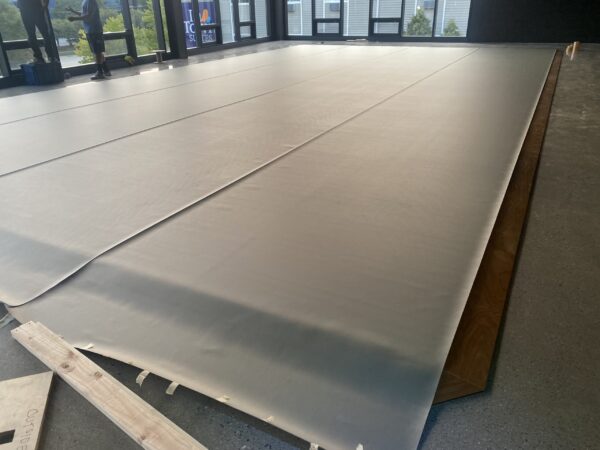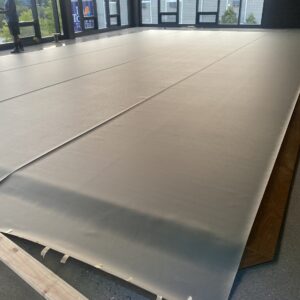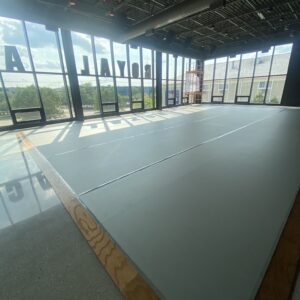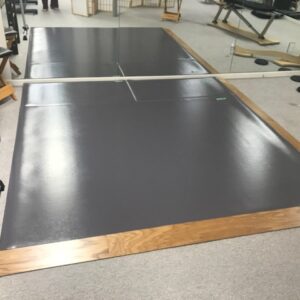The “Marley” in Marley Floor Dance Vinyl
Marley dance flooring, otherwise known as dance vinyl, is used as a blanket term for all forms of dance vinyl (just like “Kleenex” is a blanket term for facial tissue)
Construction of Dance Vinyl
What is dance vinyl? What is it made of and how is dance vinyl flooring different than other standard vinyl flooring?
For starters, vinyl is made from a base of polyvinyl chloride resins made by combining chlorine (derived from an electrolyzed solution of salt and water) with ethylene (extracted from oil). The resulting vinyl chloride monomer is the basis of all vinyl products. With slightly different resins and manufacturing methods, producers of vinyl have made what we now know as dance vinyl. Dance vinyl is a sheet flooring material that typically comes in rolls 6′ wide by up to 60′ long.
Dance vinyl is designed specifically to have a smooth surface with enough traction for dancers to glide effectively yet maintain control of their movement. Standard vinyl flooring you might at your local hardware store that are not specifically designed for dance are usually half the thickness of dance vinyl and have an improper slip-resistance making dancing on them unsafe.
There are several variations within the realm of “Marley” floor dance vinyl. The differentiation between dance vinyls is in their structure:
- The vinyl floor can be homogenous, meaning the same material type is used from top to bottom. In a homogeous dance vinyl, a smooth urethane finish is applied on top of the vinyl core during the manufacturing process and the bottom side is a raw, rough surface.
- Dance vinyl can also be double sided (this is what The Marley Company was known for). A double-sided dance vinyl has the same homogeneous vinyl material but two colors glued together, so the raw rough surface of each color is in the middle, and the two outside surfaces are both finished. With this double-sided Marley-style dance vinyl there are two finished sides, typically black and grey with a urethane finish on both sides.
- In some cases, dance floor vinyl is made with three different layers: the top layer for wear resistance, a pvc (polyvinylchloride) middle layer and a bottom layer of cushioning. This triple-layer construction makes the vinyl thicker and gives it a softer feel than the other types of dance vinyl.
- Dance vinyl flooring can also be constructed with a finished surface as the top layer, a pvc core in the middle for structure and thickness, plus a mesh and felt bottom layer that helps with stability and is ideal for gluing down to the subfloor.
The last style of dance vinyl is the construction type that O’Mara Sprung Floors has found to be the easiest to install and most durable over time. The homogenous vinyl flooring is often prone to tearing on install and the double sided dance vinyl tends to have a shorter life span, plus it expands and contracts the most in varying heat conditions. The cushioned dance vinyl can be a good option when ballet is the main focus of your studio, but is more expensive and is still not an adequate dance floor solution on its own.
The layered dance vinyl that we offer at O’Mara Sprung Floors allows you to have an ideal slip resistance in the surface layer with a flexible and durable core while the felt and mesh lined bottom create a stable and long-lasting dance vinyl that works well being glued or taped to your sprung subfloor.
What puts the Dance in Dance Vinyl Flooring
Vinyl flooring is a very common product used in all sorts of flooring applications from being used as a cheaper alternative to wood flooring in your home, to hygienic hospital floors and basketball court flooring. When considering buying a vinyl floor finish for dance you need to be certain that it gives the necessary slip resistance, durability and stability that dancers require.
A good dance vinyl accomplishes all of these things well, providing a surface that has adequate slip resistance but not so much that dancers feel as if their feet are glued into place, stopping them from gliding or turning across on the floor. When in a commercial setting having hundreds of dancers come through your studio a week, you want your dance floor vinyl to be durable enough for both the volume of dancers and the activities they are performing. Hard shoe dance like tap dance, Irish dancing and flamenco dance take a heavy toll on the wear surface of your dance floor vinyl, and following just behind those styles are hip hop and ballet which still require a very durable wear surface.
The stability of the dance floor vinyl is also very important. While it is ideal to keep the temperature conditions of your dance studio consistent, it is not always possible. Changes in heat and sunlight hitting your dance vinyl will cause your vinyl to expand and contract. While all vinyls will react to these changes, some handle it better than others. The expansion and contraction of dance vinyl is what causes the rippling effect so often seen in dance studio floors.
Marley Dance Vinyl Floor Limitations
Dance vinyl is not enough on its own to create a safe dance floor. Dance vinyl is simply a finished surface that has the necessary properties to act as a dancing surface but the structure of what makes up a good dance floor is completely missing. Every dance vinyl should be supported by a sprung floor. The sprung floor is what brings safety to the art of dance by providing the shock absorption which is crucial for protecting dancers from injury. O’Mara Sprung Floors builds a birch sprung subfloor specifically for this purpose. This sprung subfloor provides a 70% reduction in shock, plus a stable and smooth surface that is a great base for rolling out a smooth marley dance floor vinyl. The dance vinyl finish surface can either be taped down or glued in place for a permanent and lower maintenance solution.
Dangers of Marley on Concrete
Rolling “Marley” dance floor vinyl over concrete is a recipe for disaster. What looks to be an adequate dance surface from the dancers’ perspective is only an illusion. There are vinyl floor sellers out there that will claim their vinyl has adequate shock absorption for dance because they have put a thin layer of closed cell foam underneath their dance vinyl. This is wholly ineffective when it comes to reducing injury to the dancer.
A sprung subfloor underneath the vinyl is the only way to ensure your dancers are safe to practice and perform at their best with the highest probability of them leaving your studio injury free.
Our Marley Floor Options
To make your dance floor buying experience simple for you, we offer marley finish options along with the necessary sprung subfloor.
This combination addresses all aspects of dance flooring needs:
- Shock absorption to prevent injuries
- Energy return to enhance performance
- Slip-resistant surface for safety and versatility
- Durability for long-term use
Our two dance vinyl options include Ballet Floor Dance Vinyl and Stage Floor Dance Vinyl. The first, ballet floor is the most durable option. This marley-style dance floor surface is designed to offer ballet dancers the ability to dance in pointe shoes without using rosin, and it is built to withstand all styles of dance. This is the option for touring and tap. Stage Floor dance vinyl is an excellent multi-style surface, but it won’t hold up to intensive hard shoe dance as well as the Ballet Floor vinyl does and it is not designed for touring


















Reviews
There are no reviews yet.